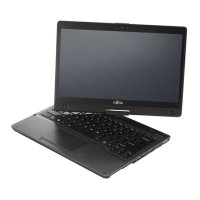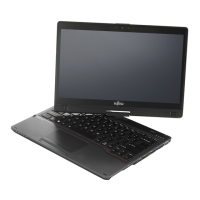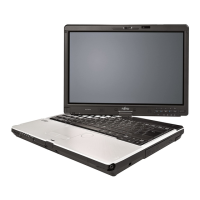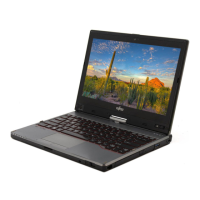
Do you have a question about the Fujitsu LIFEBOOK T938 and is the answer not in the manual?
Details on finding additional product information, drivers, and software updates online. Also covers software compatibility notes.
Identifies components visible when the notebook is open, including microphone, camera, status display, and speakers.
Details the camera, camera LED, DC input, security lock, USB 3.0, and headset/microphone ports.
Lists ports on the right side: pen slot, eyelet, memory card slot, USB 3.0 ports, HDMI, LAN, and VGA.
Identifies the battery compartment, SIM card slot, M.2 module service compartment, and port replicator port.
Essential safety information for notebook operation, including handling warnings and references to other manuals.
Specific safety precautions for devices with integrated wireless components (Wi-Fi, Bluetooth, LTE).
Recommendations for reducing power consumption and extending battery life.
Advice on preparing, transporting, and using the notebook while travelling internationally.
Instructions on how to clean the notebook, screen, keyboard, and touchpad without causing damage.
Steps for safely unpacking the device and checking for any transportation damage.
Guidelines for choosing a suitable operating location and connecting the mains adapter correctly.
Procedure for the initial power-on and setup process, including software installation.
Description of various status indicators for power, battery, drives, and keyboard functions.
Instructions for opening the notebook, switching it on, and programming the ON/OFF button.
Steps to transform the notebook into a Tablet PC by rotating the display.
How to choose between portrait or landscape screen orientation, including automatic adaptation.
Procedure for reverting the device from Tablet PC mode back to standard notebook configuration.
Instructions on how to properly shut down the notebook and close the LCD screen.
Basic interaction methods using finger tips on the touchscreen for selection and activation.
Detailed guide on single-finger gestures (tap, drag) and two-finger gestures (scroll, rotate, zoom).
Explanation of stylus pen parts, proper handling, and usage as a writing or drawing tool.
Instructions for charging the pen, configuring its settings, and attaching an optional tether.
How to use the touchpad for cursor movement, selection, dragging, and executing commands.
Overview of keyboard layout, key markings, wear, and special functions mapped with key combinations.
Guide to common key combinations using Fn, Alt, Ctrl, and Windows keys for various functions.
Instructions for charging, maintaining, monitoring, and storing the notebook battery properly.
Step-by-step guide on how to safely remove and install the notebook's rechargeable battery.
Explanation of how power management features reduce consumption and how to use power saving modes.
Details on supported memory card formats and procedures for inserting and removing cards.
Instructions for inserting and removing the SIM card, including component access.
Guide to switching wireless components on/off, setting up WLAN access, and accessing networks via LTE.
Description of port replicator features and instructions for selecting a suitable location and setup.
Step-by-step guide on docking the notebook to the port replicator and safely undocking it.
Important advice on managing passwords, making backups, and the consequences of forgotten passwords.
Instructions for setting up and configuring biometric security features like fingerprint and palm vein sensors.
Guidance on using a physical security lock and configuring BIOS password protection.
Procedures for removing passwords, and setting up password protection for system boot.
Information on Smart Card reader usage and enabling/disabling the Trusted Platform Module (TPM) for enhanced security.
How to enable the on-screen keyboard in BIOS Setup for entering BitLocker passwords.
General safety advice for connecting and disconnecting external devices to the notebook.
Instructions for connecting external displays or amplifiers using the HDMI port.
Guide to connecting analog (VGA) and digital monitors via display or DVI-D ports.
Details on connecting USB devices, including those with charging functions (Type-C, Anytime USB Charge).
Information on connecting headsets, microphones, or external speakers using the combined audio jack.
Important safety warnings and guidelines for qualified technicians performing repairs.
Steps to take before removing or changing system components, including safety and preparation.
Procedure for installing or removing memory modules, including safety notes for components.
Instructions for removing and installing an M.2 module, including cover removal and screw handling.
Steps for reattaching covers, tightening screws, and completing the component service procedure.
Overview of BIOS Setup menus and steps to start the utility, including password entry.
How to navigate, change settings, and exit the BIOS Setup Utility, including saving changes.
Procedure for diagnosing and resolving faults, including contacting the service desk.
Solutions for issues like blank screens, unreadable displays, incorrect pen movement, and keyboard input errors.
Troubleshooting steps for battery discharge, printer connectivity, and wireless network connection problems.
Resolving issues related to battery life, smart card reader recognition, and forgotten PINs.
Interpreting acoustic warnings and resolving common on-screen error messages generated by BIOS or OS.
Guide on how to reset the system to its original state using recovery options in Windows 10.
Detailed technical data for the notebook, including processor, memory, screen, camera, and ports.
Technical data for the optional port replicator, covering electrical specifications, ports, and ambient conditions.
Technical details for the notebook's mains adapter, including primary and secondary electrical ratings.
Information on product disposal, recycling, and electrical safety certification (GS).
Reference to where other relevant certification markings and supplementary information can be found.











